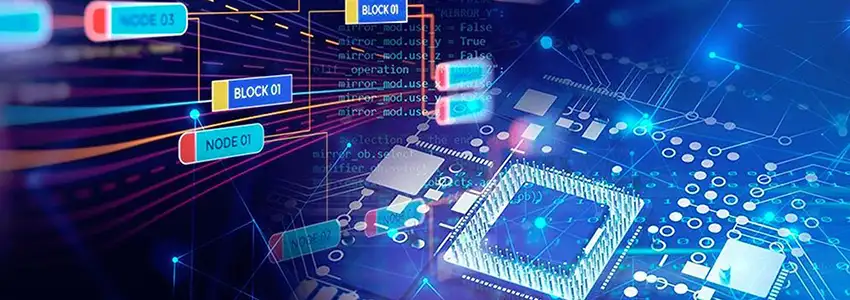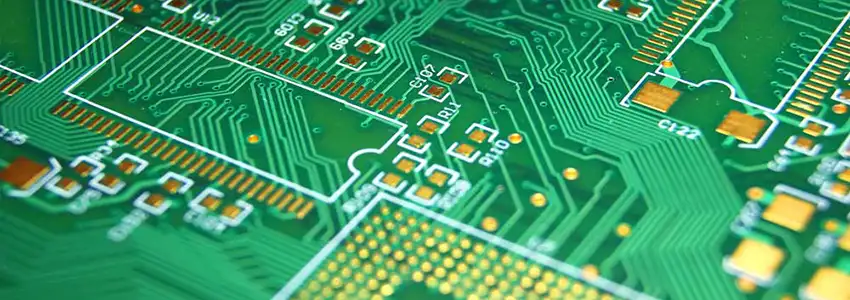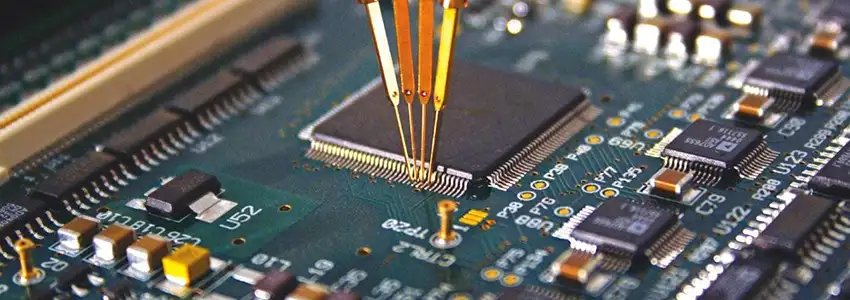- +86-0755-23597570-6067 Mon-Sun 0. 00-23. 59

Integrated circuit (IC) programming is a specialized programming technique that involves embedding software onto IC chips. This process typically utilizes a computer to serve as a bridge for program burning or programming, enabling the transfer of software to the IC. IC programming is commonly employed by technicians to program microcontrollers for controlling specific devices, but it can also be used for programming the main computer itself. The range of software that can be programmed through IC programming is vast and depends on the device being controlled.
Fastlink offers comprehensive IC programming services as part of our printed circuit board assembly (PCBA) solutions. Our IC programming technology supports a wide range of package types, including Thin Shrink Small-Outline Package (TSSOP), Plastic Leaded Chip Carrier (PLCC), Small Dual In-Line Package (SDIP), Dual In-Line Package (DIP), and more.
IC programming plays a pivotal role in the development, customization, and maintenance of electronic devices and systems. It enables the implementation of desired functionality, tailoring of hardware behavior, and the installation of firmware updates.
Through IC programming, engineers can embed complex instructions and data into integrated circuits, empowering them to perform specific tasks and operations. This customization capability allows for the creation of unique and specialized electronic systems that cater to diverse applications. Additionally, IC programming facilitates the installation of firmware updates, ensuring that devices remain up-to-date with the latest advancements and bug fixes.
IC programming also proves instrumental during the prototyping and testing stages of PCB development. It enables engineers to validate the functionality and performance of the circuit design before mass production. Thorough testing and debugging can be conducted through IC programming, refining the PCB design and ensuring its optimal operation.

Online programming uses the standard communication bus of the chip, such as UART, USB, or JTAG. This method requires fewer pins to connect and is applicable when the chip supports ISP (In-System Programming) and the PCB (Printed Circuit Board) is designed for ISP. While it is slower than offline programming, online programming offers the advantage of traceability in case of errors during production testing. This is because online programming commonly utilizes wire connections. Additionally, online programming allows for field upgrades and data file changes without rework. The number of channels supported by each ISP programmer determines the concurrent programming capacity. As programming occurs after surface mounting, there are minimal risks.
Offline programming is a common method that involves programming the chip before it is placed on the PCB. It is also known as parallel programming and is compatible with various types of adaptors and packages. This means that adapters can be used with the chip. Different adaptors are required for different packages and chips. Nowadays, packages are available in small and flat formats, such as QFN (Quad Flat Non-Leaded) and BGA (Ball Grid Array). If an error is detected, the chip can be removed from the adaptor and reprogrammed following the specified procedures. Offline programming offers faster speeds, greater reliability, and more settings compared to online programming. However, there is a risk of chip pin deformation if the programming process is not handled carefully.
Procedural languages follow a set of instructions or commands to perform specific tasks. They are commonly used by software and script programmers to read and process data. Variables and functions are utilized to develop programs that enable computers to calculate and perform various operations. Procedural languages can be created using an editor or an integrated development environment (IDE) such as Eclipse.
Procedural languages are structured around procedures and functions, which are self-contained blocks of code that perform specific tasks. These languages categorize programs into statements and variables, providing a structured approach to program development.
A script comprises a series of instructions or commands executed by another program. Script languages, such as Rexx and Perl, are popular due to their user-friendly coding process. However, these languages often require more time to run when compared to compiled languages, as they necessitate interpretation. Additionally, scripts can serve as sequential lists of operating system commands. These languages are designed to provide instructions for a runtime environment, and all script languages fall under the umbrella of programming languages.
Functional languages are specifically designed to handle list processing applications and symbolic computation. Examples of functional languages include Haskell and Python. They can be classified as pure or impure. Pure functional languages solely support functional paradigms, with Haskell being an example. Impure functional languages allow for imperative-style programming and functional paradigms. Functional languages are based on mathematical concepts and utilize recursion to perform computations.
Logic programming languages express rules and facts about problems within a formal logic system. These languages formulate rules as logical clauses. Notable examples of logic languages are Answer Set Programming (ASP) and Datalog.

Hardware compatibility is a significant challenge in IC programming, especially when the programming hardware isn’t fully compatible with the IC. This incompatibility can lead to incomplete or erroneous programming, potentially damaging the IC. To mitigate these risks, it’s crucial to ensure that the programming hardware, including firmware and adapters, is compatible with the IC’s specifications. Regular updates to the programming hardware’s firmware and the use of specific adapters designed for the IC can help avoid these issues, ensuring a smooth and accurate programming process.
Firmware corruption during programming is a common problem, often caused by transmission errors or software bugs. This corruption can render the IC non-functional or cause erratic behavior. Implementing data integrity checks, such as checksums or cyclic redundancy checks (CRC), can significantly reduce the risk of firmware corruption. These checks ensure the integrity and accuracy of the firmware after it has been programmed onto the IC, safeguarding against potential errors during the transmission process.
Programming speed is a critical factor, especially in high-volume production. Slow programming processes can lead to increased production times and costs. Optimizing the programming algorithm, utilizing faster communication interfaces, and considering parallel programming processes can enhance programming speed. These optimizations are particularly important in mass production environments where even small increases in speed can lead to significant improvements in overall throughput.
Data security during IC programming is crucial, especially when handling sensitive information. The risk of intellectual property theft or unauthorized data access is a major concern. To address these security challenges, implementing secure programming procedures is essential. This can include the encryption of data and the establishment of stringent access controls, ensuring that sensitive information remains protected throughout the programming process.
Handling and electrostatic discharge (ESD) are critical concerns in IC programming. ICs are sensitive to ESD and can be damaged by improper handling. Implementing ESD-safe procedures and environments is crucial to prevent damage to the ICs. This includes using ESD-safe workstations, grounding straps, and appropriate packaging materials to protect ICs from electrostatic damage during handling and programming.
Fastlink offers a variety of IC programming services tailored to the unique demands of your electronic projects and applications. Below are the key IC programming services we provide:
ISP enables the programming of a microcontroller directly within the device or circuit. This is particularly beneficial when the device is difficult or impossible to remove. Ideal for updating or modifying the code of microcontrollers in operation, such as those in surface mount technology (SMT) components, ISP is versatile and applicable to a broad spectrum of devices, including microcontrollers, memory chips, and field-programmable gate arrays (FPGAs).
Off-line programming allows for the programming of robots or other automated systems using computer-aided design (CAD) software, without physical system access. This method is also useful for pre-installing programs in microcontrollers before their incorporation into devices or circuits. It’s a valuable asset for high-volume PCB assembly and rapid production cycles in public electronics or commercial product sectors.
We specialize in developing software for microcontroller-based devices like Arduino, Raspberry Pi, or micro bit. Our range of services includes firmware and device driver development, prototyping, system integration, maintenance, and support. These services are fundamental to ensuring that microcontroller-based devices function effectively and are integral to the operations of larger systems.
Our services extend to a variety of embedded systems, which are integral parts of larger devices or systems, often working within resource-limited environments. Our skilled team employs advanced technologies and methods to create tailored solutions meeting our clients’ unique needs. We handle complex devices such as smartphones, automotive control systems, smart home technologies, medical equipment, and more.
Beyond circuit design and IC programming, Fastlink also offers comprehensive PCBA solutions, including cost-effective PCBA prototyping. These services are invaluable for those needing assistance in circuit design and testing before mass production. Fastlink’s prototyping services are a crucial resource for companies that lack internal expertise or resources in this area.
Our custom programming services provide software solutions tailored to the specific needs of businesses. These services encompass design, coding, testing, and deploying software applications that align with an organization’s unique requirements. Fastlink’s expert custom programming services are ideal for unique or complex projects, offering adaptable support from seasoned professionals.
IC chips are essential components of PCBA boards, enabling the customization and optimal performance of electronic products. Before integration onto PCBs, ICs undergo manufacturing and packaging processes. Subsequently, specialized software and programming languages, such as C, C++, and assembly, are employed to develop the firmware or software that will be embedded onto the ICs. Once developed, the firmware is loaded onto programming equipment to write the code onto the ICs.
The programming phase for ICs typically entails connecting them to the programming apparatus through a set of pins or a specialized interface. This equipment efficiently transmits the code into the IC, where it’s stored in the integrated circuit memory. Following this programming phase, the ICs are ready to be integrated into the PCB, joining other vital components like resistors, capacitors, and connectors. The assembly of these elements onto the PCB may be achieved through soldering or alternative methods such as SMT assembly.
Fastlink, a professional turnkey PCBA service provider, offers a comprehensive range of services, including PCB board programming. Our services empower customers to program integrated circuits with specific codes to fulfill their desired functionalities. This eliminates unnecessary complexities and ensures the optimal operation of their electronic products.